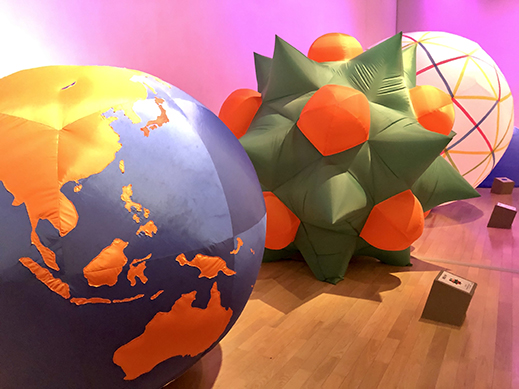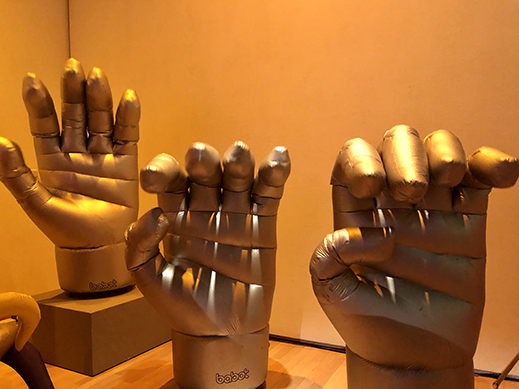 |
Focus features two in-depth reviews each month of fine art, architecture, and design exhibitions at art museums, galleries, and alternative spaces around Japan. |
|
|
 |
 |
 |
Inflated with the Spirit: Shiro Takahashi and the Kojiki
Jennifer Pastore |
 |
Installation view of the Shiro Takahashi exhibition, with Taro Okamoto's Myth (1980) at center. © Taro Okamoto |
The Taro Okamoto Museum of Art, Kawasaki marked its 20th year in 2019. On the way to this museum nestled in the wooded Ikuta Ryokuchi Park, just across the Tama River from Tokyo, my taxi driver tells me it is popular with visitors from the Osaka area, home to Okamoto's landmark public sculpture Tower of the Sun. Okamoto (1911-1996), who made a name for himself across Japan as a major postwar artist, was born in Kawasaki. The museum holds both permanent and special exhibitions, the first relating his life story, philosophy, and artistic achievements, which ranged from ethnological research on Japan's prehistoric cultures to avant-garde painting and sculpture. Okamoto became sort of a cultural phenomenon in his own right, popularizing the phrase "Art is explosion!" The current special exhibition, Shiro Takahashi and the Kojiki: Mythology, Art, Technology, fits with the museum's history of spotlighting contemporary artists who channel his ethos.
 |
|
Shiro Takahashi, Three Untouched Gods (1995), front; Pleasant Reed Mold (1994), center; and Principle of Thinking (2019), back. © Shiro Takahashi |
Shiro Takahashi (b. 1943), a former president of Tama Art University, is a pioneer of computer-controlled art. His 3-D Mechanical Sculpture Series turned heads at the Osaka Expo in 1970 with the agile movements of its twisting scaffold structures. In the 1980s, Takahashi debuted his Pneumatic Sculpture Series, balloon-shaped robots built from nylon film and wire mechanisms that he called "babots." Many of these early works became predecessors to the giant computer-controlled inflatables currently on display. Takahashi has created all manner of babots over the years, from imaginary creatures to cartoon characters and stage pieces, but for the inspiration of this show, he turned to the Kojiki, Japan's most ancient text.
Shiro Takahashi, God of Great Work (2006), left, and God of Life/Goddess of Life (2013), right. © Shiro Takahashi
|
The Kojiki, or Records of Ancient Matters, dates back to 712 when it was transcribed from oral tradition. It is a Shinto account of myths and histories describing the origins of Japan and the lineage of its gods up through the creation and reign of the Imperial court. It has long been a source text of Japanese mythology, detailing the relationships among Shinto's polytheistic deities. Japanese people today are still largely familiar with the major players, such as Amaterasu, the sun goddess, and the creator deities Izanagi and Izanami. The inflatable sculptures on display here are Takahashi's own interpretations of the Kojiki, its characters, and its stories.
Shiro Takahashi, Izanami (1980), left, and Izanagi (2003), right. © Shiro Takahashi |
Some of the gods chosen by Takahashi for representation are Izanagi and Izanami (in the exhibition, a Hulk-like figure and a woman with curling locks of hair), a squirming baby called God of Great Work, and a double-helix coil dubbed God of Life/Goddess of Life. There are a total of 41 pneumatic sculptures dating from 1972 to 2019, many of them capable of movement. Some are clear representations like God of Fire -- a bright red figure with flaming hair -- while others are more abstract, such as the pink starfish God of Immunity. There are some "foreign" gods not found in the Kojiki, such as Three Untouched Gods (a globe), and others, like Principle of Thinking, that manifest the invisible. However, most of the works fit somewhere within the Kojiki, particularly in the tale of Izanagi and Izanami.
Shiro Takahashi, God of Fire (2017), right, and Strong and Light Boat (1989), left. © Shiro Takahashi |
The story goes: Izanagi and Izanami are twins who together create the Japanese archipelago and have several children deities. Izanami dies giving birth to the God of Fire, and Izanagi's tears create Nakisawame, or, as Takahashi calls her, Goddess of Weeping Valley (depicted here as two blinking eyeballs). Izanagi descends into Yomi, the land of the dead, in search of Izanami, but she becomes angry when he sees her corpse and sends the Yomotsuikusa or Underground Army (grasping hands) after him. Izanagi manages to escape by hurling peaches at the army and sealing a boulder that traps Izanami in the underworld. Izanagi then creates more sacred children, including Amaterasu and the storm god Susanoo, when he purifies himself by bathing in a river. Filling the gallery and towering over visitors, these gods and goddesses form something like an inflatable funhouse of Japanese mythology.
Shiro Takahashi, Goddess of Weeping Valley (2008). © Shiro Takahashi |
There's more than just lighthearted amusement to appreciate here, though. Takahashi's sculptures not only remind us of Japan's origin story, they resonate with Okamoto's fascination with the duality of the ancient and the modern. While Takahashi uses cutting-edge technology to tell a story dating back millennia, Okamoto was also a student of pre-modern history. He extensively researched and promoted the aesthetic value of pottery from the ancient Jomon civilizations in his modern art. At the front and center of the gallery is a single work by Okamoto: Myth, a fiber-reinforced plastic sculpture symbolizing the god Susanoo. The work was inspired by the Izumo myths, which make up a major part of the Kojiki. The statue's humanesque figure seems just abstract enough to be either primeval or contemporary.
Then there's the spiritual nature of the terminology. In Japanese, Takahashi calls his pneumatic sculptures ‹C–Œ‘¢Œ` (kimaku zokei). The character for air, ‹C (ki), on its own means mind, spirit, or energy, echoing the Greek prefix pneuma, referring to a vital spirit or the soul. The vocabulary of the work itself speaks to metaphysical dimensions.
 |
|
Shiro Takahashi, Underground Army (1972). © Shiro Takahashi |
There might be some who wonder if Takahashi's giant inflatable sculptures are too tongue-in-cheek, if recreating gods in a medium more commonly seen in used-car lots might be a tad sacrilegious. This is not the intent or the effect of the exhibition, however. In the catalogue, art historian Toshiharu Ito insists Takahashi's works are "fitting abodes for the spirits of the gods." After all, he explains, "myths freely expand and contract, just like inflatables." Perhaps it is this literal and figurative flexibility that has allowed the tales of the Kojiki to endure for so long. There is still plenty to gain from them. As I stood looking at the gods of healing and immunity while they wriggled and expanded in this time of pandemic unease, I felt calm. People have been grappling with life and its disasters for thousands of years, I thought. It was a real come-to-Izanagi moment for me.
Shiro Takahashi, God of Immunity (1984), front, and God of Healing (folded) (1984), back. © Shiro Takahashi |
Shiro Takahashi, God of Healing (expanded) (1984). © Shiro Takahashi |
All photos are by Jennifer Pastore, by permission of the Taro Okamoto Museum of Art, Kawasaki. |
 |
 |
Jennifer Pastore
Jennifer Pastore is a Tokyo-based art fan and translator. In addition to Artscape Japan, her words have appeared in ArtAsia Pacific, Sotheby's, and other publications. She is an editor at Tokyo Art Beat. |
|
 |
|